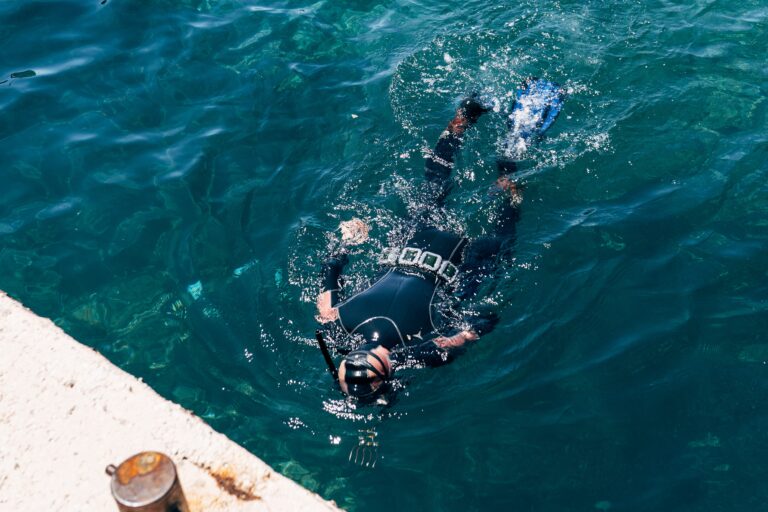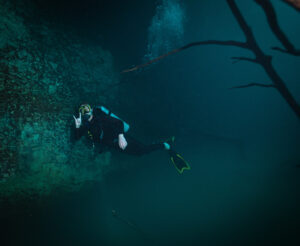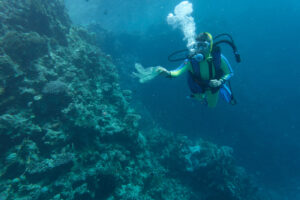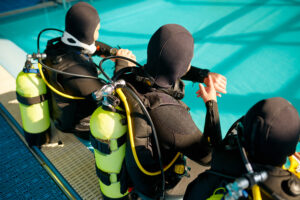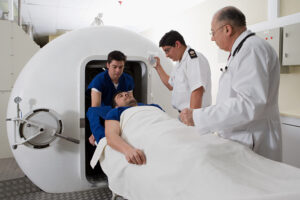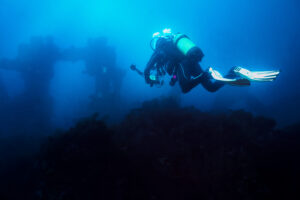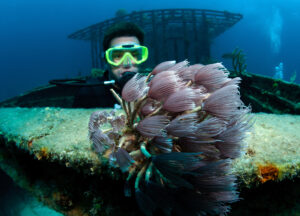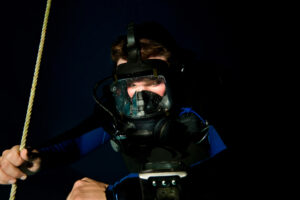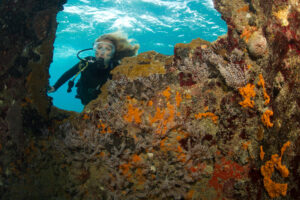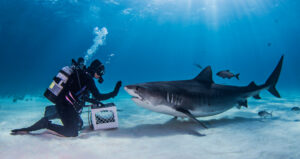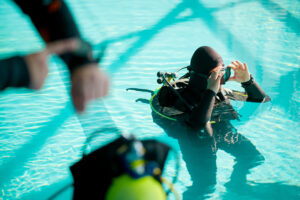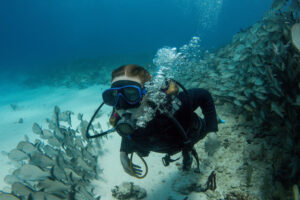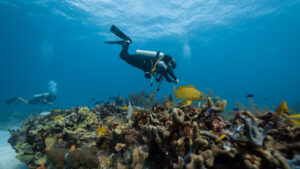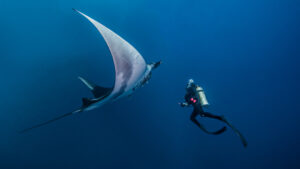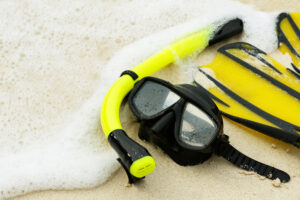What is a Trim Weight?
A trim weight is a weight specifically designed and used by scuba divers to improve their underwater buoyancy and body positioning, promoting a horizontal orientation during a dive. By adjusting the location and amount of these weights, divers can ensure a balanced and streamlined profile underwater.
Scuba diving has long necessitated methods for divers to manage and control their buoyancy. Originally, divers relied on a singular weight system, often a weight belt. However, as the sport evolved and equipment became more sophisticated, the need for improved weight distribution led to the creation of trim weights.
Purpose and Benefits of Optimal Buoyancy in Scuba Diving
Scuba diving offers individuals the remarkable opportunity to explore the underwater world, a place filled with mesmerizing marine life and unique landscapes. However, to make the most out of this experience, divers need to master the art of buoyancy control. Achieving and maintaining optimal buoyancy has numerous benefits, some of which include optimal positioning, equipment protection, enhanced visibility, and safety. This entry delves deeper into these core benefits and underscores their significance in the realm of scuba diving.
Optimal Positioning
- Efficiency in Movement: One of the fundamental advantages of attaining a horizontal position underwater is the streamlining effect it provides. When divers align themselves horizontally, they mimic the streamlined form of aquatic creatures, thus facilitating smoother movement through the water column. This orientation significantly lessens the resistance or drag experienced as they move, enabling them to glide effortlessly.
- Conservation of Air and Energy: Reduced drag not only means easier movement but also translates to a decrease in the diver’s energy expenditure. Less effort to swim means a slower heart rate and subsequently less oxygen consumption. In practical terms, this implies that divers can extend their dive time, as their air supply will last longer.
Equipment Protection
- Avoiding Contact with the Seafloor: The marine environment is delicate, and inadvertent contact can have damaging consequences. Coral reefs, for instance, are vulnerable to touch, and even a slight brush can harm them. When divers are properly balanced and maintain buoyancy, they can hover above the seafloor, minimizing the risk of damaging these fragile ecosystems.
- Preservation of Diving Gear: Diver’s equipment, including fins, cameras, and other accessories, are investments. Constant contact or scraping against the seabed can wear out this equipment faster. Maintaining buoyancy ensures that these tools remain in optimal condition for a more extended period.
Enhanced Visibility
- Optimal Viewing Angle: The underwater world is a spectacle, and divers seek to absorb as much of this beauty as possible. Being horizontally oriented places the diver in a position similar to flying over a landscape. From this vantage point, marine life can be observed without obstruction, offering a panoramic view of the environment.
- Avoiding Sediment Disturbance: A diver’s fins can stir up sediment if too close to the bottom. This can reduce visibility by creating a “silt-out” condition. By maintaining buoyancy and keeping a distance from the seabed, divers can prevent this disturbance, ensuring clear water and pristine viewing conditions.
Safety
- Depth Control: One of the core aspects of safe diving is the ability to maintain a constant depth, especially during safety stops. Safety stops, usually done at 15 feet for 3 minutes, allow divers to off-gas nitrogen, reducing the risk of decompression sickness. Proper buoyancy ensures divers can stay at this depth effortlessly.
- Preventing Rapid Ascents: An uncontrolled rapid ascent can be life-threatening due to the risk of decompression sickness or an air embolism. Mastery in buoyancy control acts as a safeguard against this, ensuring divers ascend at a safe, controlled rate.
- Energy Conservation in Emergencies: Should an emergency arise, a diver with good buoyancy control will have conserved more energy and air, crucial resources when managing unexpected situations.
Placement and Usage of Trim Weights in Scuba Diving
Scuba diving is an intricate activity, demanding attention to detail in various aspects, from equipment configuration to body positioning. One of the pivotal components ensuring a diver’s proper body orientation and movement underwater is the use of trim weights. These weights, designed to refine a diver’s buoyancy and body alignment, can be positioned in different locations based on a diver’s unique requirements. Proper placement and understanding of trim weights are paramount for both safety and efficient underwater navigation. This entry elaborates on the primary locations and the nuances of their usage.
Tank Bands
The dive tank, a diver’s primary air source, undergoes buoyancy changes as the stored air is used up during a dive. As the tank becomes lighter, its buoyancy characteristics change, which can consequently affect a diver’s buoyancy and trim.
- Placement: Trim weights can be attached directly to the tank bands, which are the straps holding the tank to the buoyancy control device (BCD). This location is especially beneficial because it allows divers to counteract the buoyancy shift directly at its source.
- Advantages: Positioning weights on the tank bands offers an efficient solution to the buoyancy shift, ensuring a consistent and stable orientation throughout the dive. This placement also keeps the weights away from the diver’s body, reducing potential discomfort.
- Considerations: Divers must ensure that weights attached to tank bands are secure, as an accidental release could change buoyancy unexpectedly. Additionally, this method might not be suitable for all tank configurations or diving conditions.
BCD Pockets
The buoyancy compensator device (BCD) is an essential piece of diving equipment that allows divers to maintain neutral buoyancy underwater. Modern BCDs often come equipped with specialized pockets, specifically designed to hold trim weights.
- Placement: These pockets are typically located on both the front and back sections of the BCD. By placing trim weights in these pockets, divers can adjust their center of gravity, helping them achieve a desired horizontal position underwater.
- Advantages: Using BCD pockets for trim weights allows for easy adjustments during the dive. Divers can fine-tune their buoyancy and orientation without needing to modify other equipment components. This positioning also provides a more integrated and streamlined weight system.
- Considerations: The exact location and design of BCD pockets can vary among different models. Divers must familiarize themselves with their specific BCD’s weight pocket system, ensuring they can efficiently secure and, if necessary, release weights.
Ankle Weights
For some divers, particularly those with buoyant legs due to the air trapped in wetsuits or drysuits, achieving horizontal trim can be challenging. Ankle weights have been introduced to address this specific issue.
- Placement: As the name suggests, these weights are designed to wrap around a diver’s ankles.
- Advantages: Ankle weights can effectively counteract the buoyancy of a diver’s legs, ensuring a more balanced and horizontal position underwater. This can be particularly useful in situations where other trim methods are insufficient.
- Considerations: The use of ankle weights has been a topic of debate among divers. Adding weight to the extremities can lead to increased leg fatigue and potentially impede a diver’s ability to kick efficiently. Prolonged use might also lead to strain on a diver’s joints. Therefore, while they offer a solution to a buoyancy issue, they should be used judiciously and might not be suitable for all divers or dive scenarios.
Considerations When Using Trim Weights in Scuba Diving
Trim weights are an essential tool for divers to achieve optimal buoyancy and body positioning. However, their usage comes with several considerations. Addressing these factors ensures that divers have a safe and environmentally conscious diving experience while maintaining ideal buoyancy.
Amount of Weight
Determining the right amount of weight is foundational to buoyancy control. Here’s why and how:
- Buoyancy Checks: Before diving, divers must conduct a buoyancy check at the surface. This involves fully deflating the buoyancy compensator device (BCD) and observing if the diver floats at eye level with a normal breath. On exhaling, the diver should sink slowly. If the diver remains buoyant, additional weight is needed.
- Changing Circumstances: The weight required can vary based on several factors including salt vs. freshwater environments (saltwater is denser), the thickness and type of wetsuit, and whether the diver is using a new tank or equipment. Each change necessitates a new buoyancy check.
- Safety Implication: Over-weighting can lead to rapid descents, increasing the risk of barotrauma or collision with the bottom. Conversely, under-weighting might result in uncontrolled ascents, risking decompression sickness.
Distribution of Weight
Achieving a horizontal underwater position is the objective of trim, and here’s how weight distribution plays a pivotal role:
- Balance and Streamlining: An even weight distribution helps divers maintain a horizontal position, reducing drag and facilitating easier movement. This not only conserves energy but also optimizes air consumption.
- Adjusting for Equipment: Dive equipment, such as tanks, can shift in buoyancy as they empty. Trim weights can counteract this shift, preventing the diver’s feet from floating upward or vice versa.
- Fine-Tuning: Every diver’s body is different, and buoyant spots can vary. Regular practice and slight adjustments in weight placement can help divers find their personal balance.
Equipment and Weight Integration
The integration of weights into diving systems has advanced buoyancy control:
- Integrated Weight Systems: Many modern BCDs come with integrated weight pockets. These allow for a more even weight distribution around the diver’s body, often resulting in a more comfortable dive.
- Quick-Release Mechanisms: An essential feature of integrated systems is the ability to quickly release weights in emergencies, ensuring a rapid ascent if needed. This feature should be intuitive to use and divers should practice weight-release regularly.
- Redundancy: While integrated systems are beneficial, it’s a good practice to have some non-integrated weights (like a weight belt) as a backup, especially for challenging dives or when diving in unfamiliar environments.
Environmental Considerations
Being environmentally aware is as much a part of diving as buoyancy control:
- Protecting Marine Life: Coral reefs and other marine habitats are delicate. An unbalanced diver can easily break coral or disturb marine life. Properly adjusted trim weights can help prevent unintentional contact with the seafloor.
- Silt and Sediments: In areas with soft bottoms, an uncontrolled descent or poor buoyancy can stir up silt, reducing visibility and potentially harming aquatic life. Good trim can mitigate this.
- Awareness is Key: Divers should always be observant of their surroundings, ensuring they don’t harm or disturb marine ecosystems, even when their trim is perfect.
Safety and Emergency Scenarios in Scuba Diving: Weight Release
Among the many safety precautions taken in the realm of scuba diving, understanding and mastering weight release systems is crucial. Weights, employed to counteract the buoyancy of a diver and their equipment, become a lifeline in certain emergency scenarios. Here, we delve deeper into the significance, mechanics, and best practices surrounding weight release.
The Role of Weights in Diving
In scuba diving, weights serve the fundamental purpose of helping divers descend and maintain neutral buoyancy underwater. Given the inherent buoyancy of items like wetsuits, drysuits, and tanks—especially as they near depletion—weights help ensure divers neither ascend too quickly nor struggle to submerge.
Mechanics of Weight Systems
There are two primary types of weight systems:
- Primary Weight System: This is the main system, commonly a weight belt or integrated weight pockets within a buoyancy control device (BCD). These weights are designed to be easily and quickly releasable in emergencies.
- Trim Weights: These are fixed weights positioned to optimize a diver’s buoyancy distribution, typically located on tank bands or within BCD pockets. Trim weights are usually not designed for rapid release.
Importance of Quick Weight Release
The ability to release weights rapidly becomes essential in certain emergencies:
- Uncontrolled Ascent: If a diver risks ascending too quickly—due to buoyancy issues or an equipment malfunction—dropping weights can slow the ascent, reducing the risk of decompression sickness or an air embolism.
- Entanglement: In scenarios where a diver becomes entangled, shedding weights can provide an immediate increase in buoyancy, facilitating a smoother ascent to the surface.
- Surface Floatation: At the surface, especially in challenging conditions, a diver may need to drop weights to remain positively buoyant, ensuring they do not get pulled under.
Mastering the Weight Drop
Given the potential life-saving role of weight release, mastering this skill is paramount:
- Regular Drills: Just as one would practice mask clearing or air sharing, dropping weights should be practiced regularly to make it an instinctual reaction.
- Equipment Familiarity: Divers must be familiar with their weight system’s release mechanism. This can vary between traditional weight belts, quick-release pockets, or integrated systems in BCDs.
- Two-Handed vs. One-Handed Release: While some systems can be released using one hand, others might require two. Recognizing and practicing the specific technique for your gear is crucial.
Preventive Measures and Best Practices
- Optimal Weighting: Over-weighting is a common mistake. Divers should regularly perform buoyancy checks to ensure they’re carrying only the necessary weight.
- Equipment Maintenance: Regularly inspect weight systems for wear and tear. Frayed belts, corroded buckles, or damaged weight pockets can hinder quick release.
- Dive Planning: Discuss weight drop procedures in dive briefings. Ensure dive buddies are familiar with each other’s equipment and release mechanisms.
- Stay Calm: Panic can hinder a diver’s ability to think and act quickly. Regular practice and mental preparedness can assist in maintaining calm during emergencies.
Trim weights play an integral role in ensuring that scuba divers maintain a balanced and streamlined position underwater. By understanding the purpose, benefits, and considerations surrounding trim weights, divers can enhance their diving experience, reduce their environmental impact, and ensure their safety. As with all diving equipment, proper training and regular practice are paramount.

